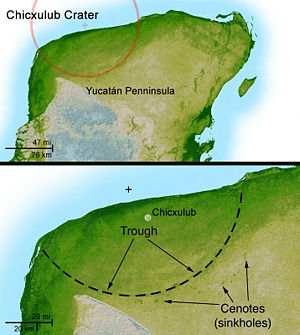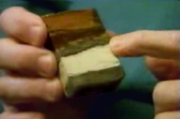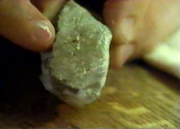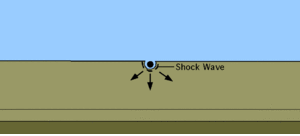Chicxulub Crater
From Wikipedia, the free encyclopedia

Chicxulub Crater (IPA: [tʃikʃuˈlub]) is an ancient impact crater buried underneath the Yucatán Peninsula, with its center located near the town of Chicxulub, Yucatán, Mexico. The crater is over 180 kilometers (112 mi) in diameter, making the feature one of the largest confirmed impact structures in the world; the asteroid or comet whose impact formed the crater was at least 10 km (6 mi) in diameter. The crater was named for the eponymous town, as well as for the literal Maya translation of the name: "tail of the devil."[1]
The crater was discovered by Glen Penfield, a geophysicist who had been working in the Yucatán while looking for oil during the late 1970s. The presence of tektites, shocked quartz and gravity anomalies, as well as the age of the rocks and isotope analysis, show that this impact structure dates from the late Cretaceous Period, roughly 65 million years ago. The impact associated with the crater is implicated in causing the extinction of the dinosaurs as suggested by the K–T boundary, although some critics disagree that the impact was the sole reason[2] and also debate whether there was a single impact or whether the Chicxulub impactor was one of several that may have struck the Earth at around the same time. Recent evidence suggests that the impactor was a piece of a much larger asteroid which broke up in a collision more than 160 million years ago.[3]
Contents |
[edit] Discovery
In 1978, Glen Penfield, a geophysicist, had been working for Petroleos Mexicanos (PEMEX, the Mexican state-owned oil company) as a staff member for an airborne magnetic survey of the Yucatán Peninsula, trying to find oil.[4] With aerial surveys, he attempted to use magnetic data to find underground oil deposits. When Penfield examined the survey data, he found a huge underground "arc", with "extraordinary symmetry" in an enormous ring, 70 km (43.5 mi) across.[1] Penfield then obtained a gravity map of the Yucatán that had been made in the 1960s. He found another arc, but this one was on the Yucatán itself, and its ends pointed north. He matched up the two maps and found that the two arcs joined up in a circle, 180 km (111 mi) wide, with its center near the village of Puerto Chicxulub. Penfield was certain that the arrangement was created by a single event in geologic history.
Although PEMEX would not allow him to release specific data, the company did allow him and PEMEX official Antonio Camargo to present their results at a geological conference in 1981.[5] The conference was under-attended that year, ironically because most geologists were attending a workshop on Earth impacts, and their report attracted very little attention. While Penfield had plenty of geophysical data sets, he had no physical evidence of an impact in the form of rock cores.[4]
Penfield knew that PEMEX had drilled exploratory wells in the region in 1951. One of the wells had bored into a thick layer of andesite about 1.3 kilometers (4,200 ft) down. Such a structure could have resulted from the intense heat and pressures of an Earth impact, but at the time of the borings it had been written off as a "volcanic dome", even though such a feature was out of place in the geology of the region. Penfield attempted to secure samples from these sites, but was told that all the samples had been lost or destroyed.[4] Attempts at returning to the drill sites and looking for rocks proved fruitless. Penfield abandoned his search, wrote up his findings, and returned to working for PEMEX at the same time scientist Luis Alvarez proposed his hypothesis that a giant extraterrestrial body had struck the earth.
Meanwhile, Alan R. Hildebrand, a graduate student at the University of Arizona, was searching for a crater, unaware of Penfield's discovery. In 1981 Hildebrand and his faculty advisor, William V. Boynton, published their preliminary theory about an earth impact.[6] Their evidence included a greenish brown coloured clay with an excess of iridium and containing shocked quartz grains and small beads of weathered glass that appeared to be tektites.[7] There was also the presence of thick, jumbled deposits of coarse rock fragments, thought to have been scoured up from one location and deposited elsewhere by a kilometers-high tsunami that most likely resulted from an Earth impact.[8] Such deposits occur in many locations but seem to be concentrated in the Caribbean Basin at the K–T boundary.[8] At the same time, Florentine Moras, a Haitan professor, discovered what he believed was evidence of an ancient volcano on Haiti; Hildebrand suggested it might be another distinctive feature of an impact nearby.[9] Tests on samples retrieved from the K–T boundary revealed more tektite glass, associated only with asteroid impacts and the site of high yield nuclear detonations.[9]
Later in 1990, Carlos Byars, a reporter for the Houston Chronicle, contacted Hildebrand and told him that Penfield had discovered what might be the impact crater years earlier, buried under the northern Yucatán Peninsula.[10] After Hildebrand got in touch with Penfield in April 1990, the two men were able to locate two separate samples from the wells drilled by PEMEX, which were stored in New Orleans, Louisiana.[11] Sending the samples back to Hildebrand, Hildebrand and his team performed tests, which clearly showed shock-metamorphic materials in the samples.
In 1996, a team of California researchers, including Kevin O. Pope, Adriana Ocampo, and Charles Duller, conducted a survey of satellite images of the region. They found that there was a ring of sinkholes centered on Puerto Chicxulub that matched the ring Penfield had found in his data. The sinkholes were likely caused by subsidence of the crater's wall.[12] Further studies have reinforced this consensus. Recent evidence suggests that the actual crater is 300 kilometers (186 mi) wide, and the 180 kilometer ring is just an inner wall.[13]
[edit] Impact specifics
The impactor's estimated size was about 10 km (6 mi) in diameter, releasing an estimated 500 zettajoules (5.0×1023 joules) of energy, equivalent to 100 teratons of TNT (1014 tons),[14] on impact. By contrast, the most powerful man-made explosive device ever detonated, the Tsar Bomba or Emperor Bomb, had a yield of only 50 megatons,[15] making the Chicxulub impact 2 x 106 times more powerful.[16]
The impact caused some of the largest megatsunamis in Earth's history, hitting the Caribbean island of Cuba especially hard. A cloud of dust, ash and steam would have spread from the crater, as the impactor burrowed underground in less than a second.[17] Pieces of the impactor, ejected out of the atmosphere by the blast, would have been heated to incandescence upon reentry, broiling Earth's surface and igniting global wildfires; meanwhile, shock waves spawned global earthquakes and volcanic eruptions.[18] The emission of dust and particles could have covered the entire surface of the earth for several years, possibly a decade, creating a harsh environment for living things to survive in. The shock production of carbon dioxide caused by the destruction of carbonate rocks would have led to a dramatic greenhouse effect,[19] and sunlight would have been filtered out by dust particles in the atmosphere. The photosynthesis of plants would be interrupted, subsequently affecting the entire food chain.[20][21]
[edit] Geology and morphology
In their 1991 paper, Hildebrand, Penfield, and company described the geology and composition of the impact feature.[22] The rocks above the impact feature are layers of marl and limestone reaching to almost 1000 meters (3280 ft) in depth. These rocks date back as far as the Paleocene.[23] Below these layers lie more than 500 m (1640 ft) of andesite glass and breccia. These andesitic igneous rocks were found only within the supposed impact feature; similarly, quantities of feldspar and augite, normally only found in impact-melt rocks, are present,[24] as is shocked quartz.[23] In addition, the K–T boundary inside the feature is depressed between 600 and 1100 m compared to the normal depth of about 500 m (1640 ft) depth 5 km (3.1 mi) away from the impact feature.[25] Along the edge of the crater are clusters of cenotes or sinkholes, which suggest that there was a water basin inside the feature during the Tertiary period, after the impact-[25] such a basin's groundwater dissolved the limestone and created the caves and cenotes beneath the surface.[26] The paper also noted that the crater seemed to be a good candidate source for the tektites reported at Haiti.[27]
[edit] Origin
On September 5, 2007 a report was issued in Nature that proposed a possible origin of the asteroid that created Chicxulub Crater.[20] The authors, William F. Bottke, David Vokrouhlický, and David Nesvorný argue that a collision occurred in the asteroid belt 160 million years ago that resulted in the creation of the Baptistina family of asteroids, the largest surviving member of which is 298 Baptistina, and that the "Chicxulub asteroid" was also a member of this group. The connection between Chicxulub and Baptistina is supported by the large amount of carbonaecous material present in microscopic fragments of the impactor, suggesting the impactor was a member of a rare class of asteroids called carbonaceous chondrites, like Baptistina.[3] According to Bottke, the Chicxulub impactor was a fragment of a much larger parent body about 170 km (105 mi) across, with the other impacting body being around 60 km (37 mi) in diameter.[28][3] It has been speculated that the impactor that produced the 85 km diameter lunar crater Tycho 108 million years ago was another member of the same group.
[edit] Chicxulub and dinosaur extinction

The size and damage that would have been wrought by the Chicxulub impact is in good agreement with the theory postulated by the late physicist Luis Alvarez and his son, geologist Walter Alvarez, for the extinction of the dinosaurs. The Alvarezes, at the time both faculty members at the University of California, Berkeley, postulated that the extinction of the dinosaurs, roughly contemporaneous with the K–T boundary, could have been caused by just such a large impact.[29] This theory is now widely, though not universally, accepted by the scientific community. Some critics, including paleontologist Robert Bakker, argue that such an impact would have killed frogs as well as dinosaurs, yet the frogs survived the extinction event.[30] Gerta Keller of Princeton University argues that recent core samples from Chicxulub prove the impact occurred about 300,000 years before the extinction of the dinosaurs, and thus could not have been the cause of their demise.[31]
The main evidence present of such an impact, besides the crater itself, is a widespread, thin layer of clay present in the K–T boundary across the world. In the late 1970s, the Alvarezes and colleagues reported[32] that it contained an abnormally high concentration of iridium. In this layer, iridium levels reached 6 parts per billion by weight or more compared to 0.4[33] for the Earth's crust as a whole; in comparison, meteorites can contain around 470 parts per billion[34] of this element. It was hypothesised that the iridium was spread into the atmosphere when the impactor was vapourized and settled across the Earth's surface amongst other material thrown up by the impact, producing the relatively iridium-rich layer of clay.[35]
[edit] Multiple impact theory
- See also: Roche limit
In recent years, several other craters of around the same age as Chicxulub have been discovered, all between latitudes 20°N and 70°N. Examples include the Silverpit crater in the North Sea, and the Boltysh crater in Ukraine. Both are much smaller than Chicxulub, but likely to have been caused by objects many tens of metres across striking the Earth.[36] This has led to the hypothesis that the Chicxulub impact may have been only one of several impacts that happened nearly at the same time. Another possible crater thought to have been formed at the same time is the Shiva crater, though the structure's status as a crater is contested.[37]
The collision of Comet Shoemaker-Levy 9 with Jupiter in 1994 proved that gravitational interactions can fragment a comet, giving rise to many impacts over a period of a few days if the comet should collide with a planet. Comets frequently undergo gravitational interactions with the gas giants, and similar disruptions and collisions are very likely to have occurred in the past.[38] This scenario may have occurred on Earth 65 million years ago.[39]
In late 2006, Ken MacLeod, a geology professor from the University of Missouri–Columbia, completed an analysis of sediment below the ocean's surface bolstering the single-impact theory. MacLeod conducted his analysis approximately 4,500 kilometers (2,800 mi) from the Chicxulub Crater to control for possible changes in soil composition at the impact site while still close enough to be affected by the impact. The analysis revealed there was only one layer of impact debris in the sediment, indicating only one impact.[40] Reuters quoted multiple-impact proponent Gerta Keller as saying, "Unfortunately, these claims are rather hyper-inflated and do not withstand close examination."[41]
[edit] See also
- Cretaceous–Tertiary extinction event
- Permian–Triassic extinction event
- Wilkes Land crater
- Vredefort Crater
[edit] Notes
- ^ a b Penfield.
- ^ Bakker interview. "Does the [impact theory] explain the extinction of the dinosaurs? There are problems..."
- ^ a b c Bottke, Vokrouhlicky, Nesvorny.
- ^ a b c Bates.
- ^ Weinreb.
- ^ Mason.
- ^ Hildebrand, Penfield, et al.
- ^ a b Hildebrand interview: "Similar deposits of rubble occur all across the southern coast of North America [...] indicate that something extraordinary happened here."
- ^ a b Morás.
- ^ Frankel, 50.
- ^ Hildebrand interview.
- ^ Pope, Baines, et al.
- ^ Sharpton & Marin.
- ^ Bralower, et al.
- ^ Adamsky and Smirnov, 19.
- ^ Adamsky and Smirnov, 20.
- ^ Milosh, interview.
- ^ Milosh. "On the ground, you would feel an effect similar to an oven on broil, lasting for about an hour [...] causing global forest fires."
- ^ Hildebrand, Penfield, et al; 5.
- ^ a b Perlman.
- ^ Pope, Ocampo, et al.
- ^ Hildebrand, Penfield, et al; 1.
- ^ a b Hildebrand, Penfield, et al; 3.
- ^ Grieve.
- ^ a b Hildebrand, Penfield, et al; 4.
- ^ Kring, "Discovering the Crater".
- ^ Sigurdsson.
- ^ Ingham.
- ^ Alvarez, W. interview.
- ^ Kring, "Environment Consequences".
- ^ Keller, et al.
- ^ Alvarez.
- ^ Web Elements.
- ^ Quivx.
- ^ Mayell.
- ^ Stewart.
- ^ Mullen, "Shiva".
- ^ Weisstein.
- ^ Mullen, "Multiple Impacts".
- ^ Than.
- ^ Dunham.
[edit] References
- Adamsky, Viktor; Smirnov, Yuri (1994). "Moscow's Biggest Bomb: the 50-Megaton Test of October 1961". Cold War International History Project Bulletin (4): 19–21.
- Alvarez, W.; L.W. Alvarez, F. Asaro, and H.V. Michel (1979). "Anomalous iridium levels at the Cretaceous/Tertiary boundary at Gubbio, Italy: Negative results of tests for a supernova origin". Christensen, W.K., and Birkelund, T. Cretaceous/Tertiary Boundary Events Symposium 2: 69.
- Bates, Robin (series producer), Chesmar, Terri and Baniewicz, Rich (associate producers). The Dinosaurs! Episode 4: "Death of the Dinosaur" [TV-series]. PBS Video, WHYY-TV.
- Bakker, Robert T.
Interview: The Dinosaurs: Death of the Dinosaur. 1990, WHYY.
- Hildebrand, Alan. Interview: The Dinosaurs: Death of the Dinosaur. 1992, WHYY.
- Milosh, Gene. Interview: The Dinosaurs: Death of the Dinosaur. 1992, (1990): WHYY.
- Moras, Florentine. Interview: The Dinosaurs: Death of the Dinosaur. 1992, (filmed 1990): WHYY.
- Penfield, Glen. Interview: The Dinosaurs: Death of the Dinosaur. 1992, WHYY.
- Hildebrand, Alan. Interview: The Dinosaurs: Death of the Dinosaur. 1992, WHYY.
- Bottke, W.F.; Vokrouhlicky, D., Nesvorny, D. (September 2007). "An asteroid breakup 160 Myr ago as the probable source of the K/T impactor". Nature 449: 23-25. Retrieved on 2007-10-03.
- Bralower, Timothy J.; Charles K. Paull and R. Mark Leckie (April 1998). "The Cretaceous–Tertiary boundary cocktail: Chicxulub impact triggers margin collapse and extensive sediment gravity flows". Geology: 122-124. Retrieved on 2007-09-25.
- Dunham, Will (2006-11-30). Single massive asteroid wiped out dinosaurs: study. physadvice.net. Retrieved on 2007-09-29.
- Frankel, Charles (1999). The End of the Dinosaurs: Chicxulub Crater and Mass Extinctions (in English). Cambridge University Press, 236. ISBN 0521474477.
- Grieve, R. (1975). "Petrology and Chemistry of the Impact Melt at Mistastin Lake Crater". Geological Society of America Bulletin 86: 1617–1629.
- Hildebrand, Alan R.; Penfield, Glen T.; Kring, David A.; Pilkington, Mark; Zanoguera, Antonio Camargo; Jacobsen, Stein B.; Boynton, William V. (September 1991). "Chicxulub Crater; a possible Cretaceous/Tertiary boundary impact crater on the Yucatan Peninsula, Mexico". Geology 19 (9): 867–871.
- Keller, Gerta; Adatte, Thierry; Berner, Zsolt; Harting, Markus; Baum, Gerald; Prauss, Michael; Tantawy, Abdel; Stueben, Doris (2007). "Chicxulub impact predates K–T boundary: New evidence from Brazos, Texas". Earth and Planetary Science Letters: 1-18. Retrieved on 2007-09-25.
- Kring, David A. (2003). "Environmental consequences of impact cratering events as a function of ambient conditions on Earth". Astrobiology 3 (1): 133–152. PMID 12809133.
- Kring, David A.. Discovering the Crater. lpl.arizona.edu. Retrieved on 2007-10-12.
- Ingham, Richard (2007-09-05). Traced: The asteroid breakup that wiped out the dinosaurs. new.yahoo.com. Retrieved on 2007-09-27.
- Mason, Moya K. (2007). In Search of a Key Paper. moyak.com. Retrieved on 2007-10-03.
- Mayell, Hillary (2005-05-15). Asteroid Rained Glass Over Entire Earth, Scientists Say. National Geographic News. Retrieved on 2007-10-01.
- Mullen, Leslie (2004-11-04). "Deep Impact - Shiva: Another K–T Impact?". Astrobiology Magazine. Retrieved on 2007-09-29.
- Mullen, Leslie (2004-10-21). Did Multiple Impacts Pummel Earth 35 Million Years Ago?. spacedaily.com. Retrieved on 2007-09-29.
- Perlman, David (2007-09-06). Scientists say they know where dinosaur-killing asteroid came from. sfdaily.com. Retrieved on 2007-10-03.
- Pope KO, Baines KH, Ocampo AC, Ivanov BA (1997). "Energy, volatile production, and climatic effects of the Chicxulub Cretaceous/Tertiary impact". Journal of Geophysical Research 102 (E9): 245–64. PMID 11541145.
- Pope KO, Ocampo AC, Kinsland GL, Smith R (1996). "Surface expression of the Chicxulub crater". Geology 24 (6): 527–30. PMID 11539331.
- Rojas-Consuegra, R., M. A. Iturralde-Vinent, C. Díaz-Otero y D. García-Delgado (2005). "Significación paleogeográfica de la brecha basal del Límite K/T en Loma Dos Hermanas (Loma del Capiro), en Santa Clara, provincia de Villa Clara. I Convención Cubana de Ciencias de la Tierra.". Geociencias 8 (6): 1–9. ISBN 959-7117-03-7.
- Sharpton VL, Marin LE (1997). "The Cretaceous–Tertiary impact crater and the cosmic projectile that produced it". Annals of the New York Academy of Sciences 822: 353–80. PMID 11543120.
- Stewart, S. A. & Allen, P. J. (2005). "3D seismic reflection mapping of the Silverpit multi-ringed crater, North Sea". Geological Society of America Bulletin 117 (3): 354–368. doi:10.1130/B25591.1.
- Than, Ker (2006-11-28). Study: Single Meteorite Impact Killed Dinosaurs. livescience.com. Retrieved on 2007-09-29.
- Web Elements (2007). Geological Abundances. webelements.com. Retrieved on 2007-09-26.
- Weinreb, David B. (March 2002). Catastrophic Events in the History of Life: Toward a New Understanding of Mass Extinctions in the Fossil Record - Part I. jyi.org. Retrieved on 2007-10-03.
- Weisstein, Eric W. (2007). Eric Weisstein's World of Physics - Roche Limit (English). scienceworld.wolfram.com. Retrieved on September 5, 2007.
- Qivx Inc. (2003). Periodic Table: Properties of Iridium. qivx.com. Retrieved on 2007-09-25.
[edit] External links
- Satellite image of the region (from Google Maps)
- NASA JPL: "A 'Smoking Gun' for Dinosaur Extinction", March 6, 2003
- Chicxulub, Crater of Doom
| Cretaceous-Tertiary extinction event | |
| Craters found at the K-T boundary | |
| Boltysh crater | Chicxulub Crater |
| Shiva crater | Silverpit crater |



